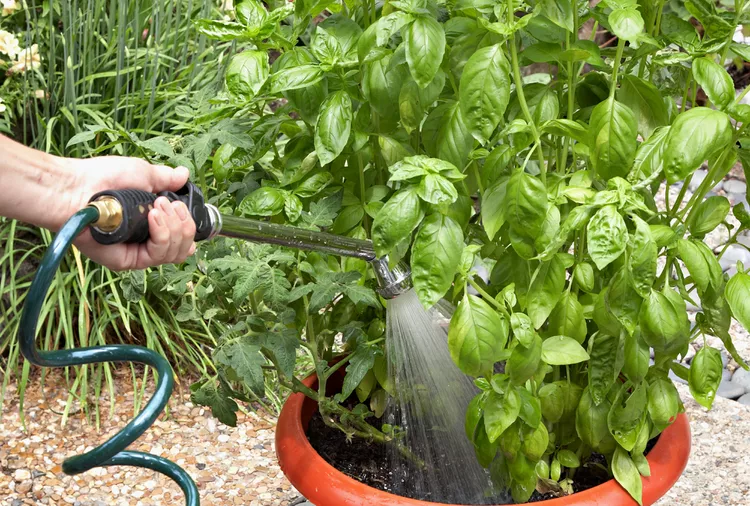Knowing how often to water basil can be a bit tricky because this herb's watering needs will vary depending on the age of the plant, the weather, the season, the soil, and where your plant is growing. With all that fluctuation, it’s all too common for gardeners to lose basil leaves or even entire plants to overwatering or underwatering. These tips for watering basil will help you water your plants the right way every time.
How Much Water Basil Needs
Unlike Mediterranean herbs, like lavender and rosemary, basil has tender stems and delicate leaves that need a lot of water to grow properly. These plants do best when they’re provided with about 1 to 2 inches of water per week, but watering will vary depending on your plant’s growing conditions.
Basil prefers to grow in consistently moist soil with good drainage and plants should never be allowed to completely dry out. Watering basil regularly prevents dry and crispy leaves, but it also slows down bolting and encourages basil plants to grow more vigorously. That said, basil can develop root rot if it’s watered too often, so it’s important to figure out a watering schedule that works for you and your plants.
Watering Basil Plants in Pots
When growing basil in pots, your plants will usually need to be watered more often than plants grown in garden beds. In outdoor herb gardens, plant roots are buried deep in the soil and all that earth provides insulation and keeps soil moisture from evaporating too quickly. However, when basil plants are grown in pots, their roots are relatively exposed on all sides, which allows moisture to evaporate faster and increases the amount of water plants will need.
Herbs grown in terracotta pots or grow bags will usually dry out faster than plants in plastic containers, and outdoor potted basil will typically need to be watered more frequently than indoor plants. Outdoor basil in containers should be watered about once every 1 to 3 days during summer and less often in cool weather, while indoor potted basil should be watered about once a week.
Always feel the soil before watering basil and only water when the top 1 to 2 inches of soil feels dry to the touch.
How Often to Water Basil Plants in Gardens
Basil in garden beds usually doesn’t need water as often as basil that’s grown outdoors in pots. A good rule of thumb is to water basil in culinary gardens about once every 1 to 3 days in hot weather and every 5 to 7 days in cool weather, but this can vary depending on weather patterns and other factors.
When temperatures are above 95°F, basil should be watered daily and protected with shade cloth so its delicate leaves don’t develop sun damage. Be sure to check your basil daily for drooping leaves, wilted stems, and other signs that it’s thirsty and water whenever your plants look like they need a drink.
Watering Indoor Basil Seeds and Seedlings
Basil seeds and seedlings that are started indoors are typically watered once a day during their first few weeks of plant life. As with mature basil, basil seeds and seedlings should be watered often enough so that the soil remains moist and doesn’t completely dry out. Since basil seedlings can be quite delicate, it’s usually best to water young plants with a hand sprayer and water again when the top of the soil feels dry.
More Watering Tips for Basil Plants
Beyond watering frequency, it’s also important to know how to water basil if you want to keep these edible plants as healthy as possible. Use these basil watering tips for lush, leafy growth and thriving herb plants:
- Overwatering in basil plants can look like: brown or black spots on plant leaves, yellow leaves near the base of the plant, and wilted stems even though the soil feels wet. If this occurs, let your plant dry out before watering again and reduce watering frequency in the future.
- Underwatering in basil can look like: wilted, droopy plants with brown and crispy leaves and dry soil. If this occurs, water your plant promptly and increase your watering frequency to help your plants recover. Indoor basil can also develop crispy leaves due to low humidity levels, but this can be prevented with a humidifier or pebble tray.
- Always water basil plants in the morning and direct water to the soil to keep leaves as dry as possible. This helps prevent powdery mildew and other plant diseases.
- For a sturdy root system, water basil plants slowly for a longer period of time to ensure water gets deep into the soil.
- Adding compost to your soil and applying a 1- to 3-inch layer of mulch on top keeps soil from drying out as quickly.
- To prevent root rot, always grow basil in well-draining pots and allow excess water to drain away from the pot before placing the plant back on its saucer.
- Soil moisture meters can help you avoid overwatering or underwatering basil plants.
- Frequent travelers may want to invest in a drip irrigation system or self-watering planters to keep their basil well-watered while they’re away.




















